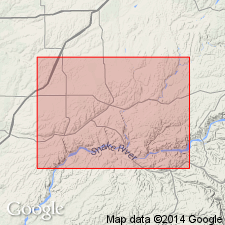
- Usage in publication:
-
- Devils Canyon Soil
- Modifications:
-
- Named
- Dominant lithology:
-
- Paleosol
- Loess
- Ash
- AAPG geologic province:
-
- Eastern Columbia basin
Summary:
Named for Devils Canyon [probably near town of Connell], in Cheney-Palouse Scabland Tract of the Channeled Scabland, Adams Co., southeastern WA. Type locality is a composite of six roadcuts recognized across 100 km transect here called "type transect". Strata previously assigned to [late Pleistocene] Palouse loess (informal). Described as well developed and readily distinguished from overlying, weakly altered loess. Cambic horizon has higher color value and chroma than those of adjacent horizons, weak prismatic to subangular blocky structure, and 4 to 25% weakly cemented cylindrical nodules increasingly abundant downward. Petrocalcic horizon slightly redder than late Pleistocene Washtucna Soil (new). Late Pleistocene (may be earlier Mount St. Helens pre-set C) tephra layer lies near base of unit. Maximum thickness is 2.5 m at KP-1 roadcut of "type transect". Overlies older unconformity defined by scoured soils and conceivably a result of older episode of Scabland flooding. Unconformably underlies late Pleistocene (>35,000 yr B.P.) Old Maid Coulee Soil (new). Age is late Pleistocene (older than 35,000 yr B.P.) based on stratigraphic position below Mount St. Helens set C tephra and presumed to have occurred between two older episodes of Scabland flooding during a late Illinoian glaciation about 130,000 to 200,000 yr B.P. Report includes stratigraphic column and correlation chart.
Source: GNU records (USGS DDS-6; Menlo GNULEX).
For more information, please contact Nancy Stamm, Geologic Names Committee Secretary.
Asterisk (*) indicates published by U.S. Geological Survey authors.
"No current usage" (†) implies that a name has been abandoned or has fallen into disuse. Former usage and, if known, replacement name given in parentheses ( ).
Slash (/) indicates name conflicts with nomenclatural guidelines (CSN, 1933; ACSN, 1961, 1970; NACSN, 1983, 2005, 2021). May be explained within brackets ([ ]).

